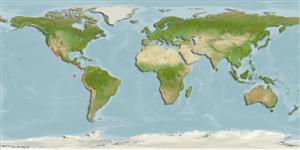Teleostei (teleosts) >
Eupercaria/misc (Various families in series Eupercaria) >
Priacanthidae (Bigeyes or catalufas)
Etymology: Pristigenys: Greek, pristis = saw + Greek, genys, -yos = face (Ref. 45335).
More on author: Gilbert.
Environment: milieu / climate zone / depth range / distribution range
Ecology
Marine; reef-associated; depth range 5 - 100 m (Ref. 9335), usually 25 - 75 m (Ref. 39763). Subtropical; 37°N - 56°S, 123°W - 72°W
Eastern Pacific: Monterey Bay in California, USA along continental shelf to Peru, including Revillagigedo, Cocos and the Galapagos Islands.
Size / Weight / Age
Maturity: Lm ? range ? - ? cm
Max length : 34.0 cm TL male/unsexed; (Ref. 55763); common length : 20.0 cm TL male/unsexed; (Ref. 55763)
A shy nocturnal fish that prefers the deeper water around islands. It may be found with squirrelfishes and cardinalfishes but tends to range deeper than they do (76 m). Known to occur at depths of less than 5 to over 100 m in rocky habitats (Ref. 5403).
Life cycle and mating behavior
Maturity | Reproduction | Spawning | Eggs | Fecundity | Larvae
Starnes, W.C., 1988. Revision, phylogeny and biogeographic comments on the circumtropical marine percoid fish family Priacanthidae. Bull. Mar. Sci. 43(2):117-203. (Ref. 5403)
IUCN Red List Status (Ref. 130435: Version 2024-1)
Threat to humans
Harmless
Human uses
Fisheries: of no interest
Tools
Special reports
Download XML
Internet sources
Estimates based on models
Preferred temperature (Ref.
123201): 15.2 - 26, mean 19.4 °C (based on 58 cells).
Phylogenetic diversity index (Ref.
82804): PD
50 = 0.5313 [Uniqueness, from 0.5 = low to 2.0 = high].
Bayesian length-weight: a=0.02754 (0.01393 - 0.05445), b=2.94 (2.76 - 3.12), in cm total length, based on LWR estimates for this species & (Sub)family-body (Ref.
93245).
Trophic level (Ref.
69278): 4.0 ±0.67 se; based on food items.
Resilience (Ref.
120179): High, minimum population doubling time less than 15 months (Preliminary K or Fecundity.).
Fishing Vulnerability (Ref.
59153): Low vulnerability (24 of 100).
Nutrients (Ref.
124155): Calcium = 34.9 [15.1, 83.8] mg/100g; Iron = 0.619 [0.321, 1.106] mg/100g; Protein = 19.7 [18.5, 20.9] %; Omega3 = 0.198 [0.109, 0.361] g/100g; Selenium = 19.1 [8.6, 39.6] μg/100g; VitaminA = 27.3 [6.7, 114.1] μg/100g; Zinc = 0.612 [0.379, 0.942] mg/100g (wet weight);
